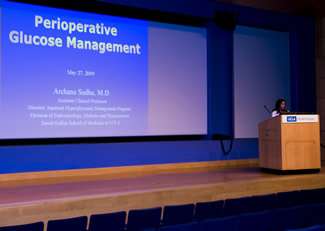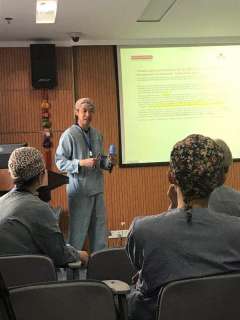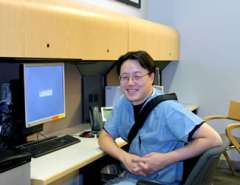Resident Teaching Beyond the OR
Our teaching program complements the broad, intense clinical experience that residents and fellows gain at UCLA. There are three main components:
- Education in the science and research behind clinical anesthesiology
- The skills of applied anesthesiology in the care of each patient
- Preparation for the written, oral and OSCE (Objective Structured Clinical Examination) portions of the American Board of Anesthesiology (ABA) examination process.
The Internship (PGY-1) Year
The intern clinical base year provides the residents with broad educational experiences as the prequel to the practice of anesthesiology. Our PGY-1 residents participate in daily lunchtime teaching conferences given by the UCLA Department of Internal Medicine. Conferences include lectures by faculty members, resident report, intern intake, morbidity and mortality teaching conferences, journal club, and ethics conference.
During the initial month of anesthesiology training, interns have their first 1:1 hands-on teaching in the operating room, and they attend interactive lectures, workshops, and simulator sessions led by faculty with expertise in different anesthesia subspecialties. The curriculum highlights the basics of anesthesiology practice, including airway management and fluid management. PGY-1 residents also interact with our Human Patient Simulators at the UCLA Simulation Center. They participate in scenarios including the induction of general anesthesia, emergence from anesthesia, hypoxia, and hemodynamic changes. The PGY1 Intensive Learning Series is the foundation of the knowledge, skills, and clinical judgment essential to anesthesiology.
Resident Didactic Program (CA-1 to CA-3)

Our interactive teaching program takes place on Tuesday afternoons for all anesthesiology residents at the Ronald Reagan UCLA Medical Center, Jules Stein Eye Institute, and the Ambulatory Surgery Center. Residents are relieved from all OR and clinical duties in order to attend. The program consists of practice-based learning discussions, case conferences, keyword, board review, simulator sessions, and lectures given by our faculty and by well-known visiting professors.
Each residency class has its own sessions tailored to the group's level of training, built around a subject-of-the-month concept.
- Our CA-1 program provides fundamental knowledge as preparation for the Basic Examination administered by the ABA. Highlights include ultrasound-guided regional anesthesia and central line skills workshops, as well as our basic exam preparation and review sessions.
- Our CA-2 program focuses on more advanced topics in subspecialty anesthesiology, with workshops utilizing the Human Patient Simulators and interactive presentations. Highlights include sessions on neurosurgical emergencies, obstetric anesthesia, pediatric anesthesia, trauma anesthesia, and TTE/TEE skills workshops. Our CA-2 residents also learn the important responsibilities that come with being "team captain" for the on-call team and code leaders in the hospital.
- The CA-3 program covers topics on the ABA written and oral board examinations, and advanced topics in practice management and quality improvement. Highlights include monthly written and oral board review sessions led by faculty experts who serve as board examiners. CA-3 residents also have the opportunity to lead journal club meetings, present keywords to junior residents, and teach CA-1 residents how to place central lines. Our senior residents gain progressive responsibility and develop the clinical skills, knowledge, and attitudes to equip them for independent practice after residency.

Workshops and Simulator Sessions Include:
- Anesthesia for valvular surgery
- Neurosurgical emergencies
- Ventilator management and trouble-shooting
- Adult and pediatric airway management
- Regional anesthesia techniques, including use of ultrasound
- Epidural and spinal placement
- Transesophageal and transthoracic echocardiography (TEE/TTE).
Grand Rounds
Our Grand Rounds program is an ACCME-accredited weekly offering offered each Wednesday morning, with a formal presentation followed by a question-and-answer session. These lectures cover a wide spectrum of topics presented by our own faculty, visiting professors, experts from other UCLA departments, and our own residents and fellows. One session each month serves as a Morbidity and Mortality Conference.
Journal Clubs
We hold several journal clubs throughout the year in different subspecialties, offering critical review and analysis of key articles in the scientific literature.
Patricia A. Kapur, MD, Visiting Professor Program
Our Visiting Professor Program is named in honor of Patricia A. Kapur, MD, who served with distinction as chair of our department for 17 years. Dr. Kapur also served as President of the ABA, President of the Foundation of Anesthesia Education and Research, as a section editor of the journal Anesthesia & Analgesia, and as Chair of the Board of Trustees of the International Anesthesia Research Society. She was a member of the governing Councils of the Association of University Anesthesiologists, the Society of Academic Anesthesiology Associations, and the Association of Academic Anesthesiology Chairs, and served on the Board of Directors and the Executive Committee of the Anesthesia Patient Safety Foundation.
Our department invites visiting professors to our hospital each year to broaden our perspectives on important current topics. These visiting professors present talks and discuss cases during our Tuesday afternoon resident sessions and Grand Rounds.
Examinations
Our department administers examinations to our residents to provide them with a standardized benchmark of their progress throughout training. All residents (PGY-1 through PGY-4) sit for the annual ABA-ASA In-Training Exam (ITE). CA-1 residents sit for the Anesthesia Knowledge Test (AKT-6) after 6 months of anesthesia training. We offer the AKT-24 to residents who may benefit from additional exam practice. We also offer the opportunity to practice for the oral board examination in mock sessions given by faculty who are ABA examiners.
Textbooks, Society Memberships, and Educational Funds
Residents are provided with basic textbooks and membership in professional societies. They receive an educational stipend of $500 per academic year. Those who excel on their CA-1 and CA-2 ITE receive an additional $1000 in education funds.

Libraries
Our Residents' Library is conveniently located adjacent to the Anesthesiology Education Office in the Ronald Reagan UCLA Medical Center. It is supplied with computers, printers, a copier, and scanner. along with texts, periodicals, and demonstration mannequins. This room has been prepared for study with comfortable furnishings including white boards and a projection screen for small-group discussions. A DVD player and monitor are provided along with an extensive selection of educational videos. Residents are able to access their email accounts and CareConnect, our EMR system, via the library computers.
The UCLA Center for the Health Sciences (across the street from the Ronald Reagan UCLA Medical Center) maintains the Louise M. Darling Biomedical Library, which contains more than 678,235 print volumes, and provides access to electronic resources including journals, databases, and other materials.